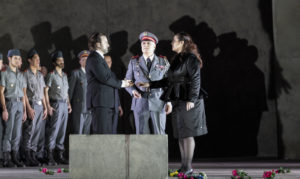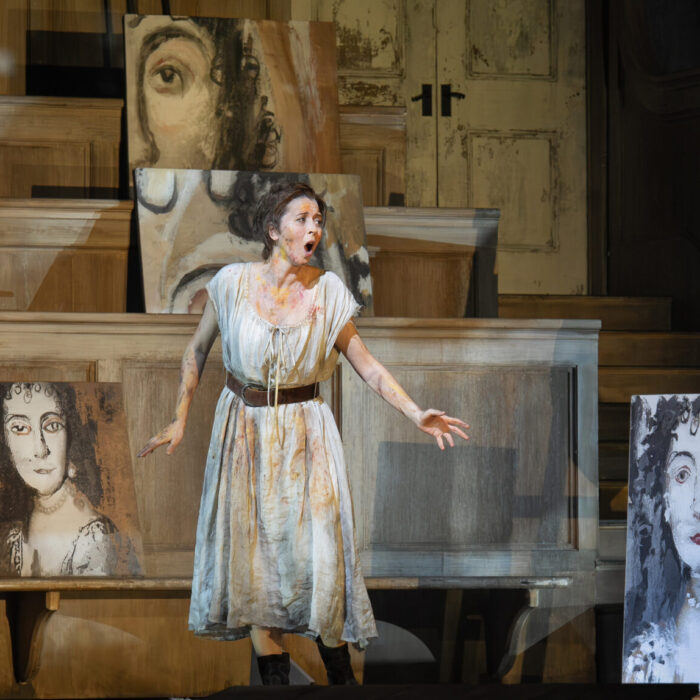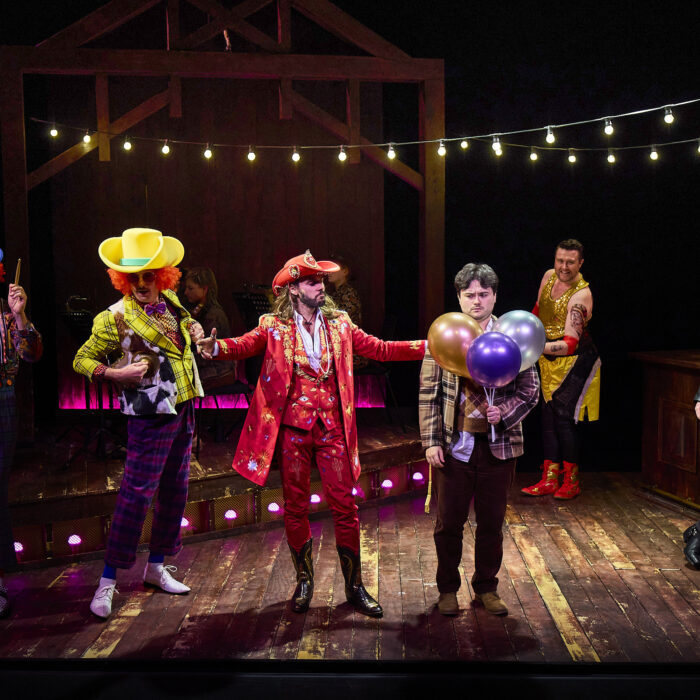
Teatro dell’Opera di Roma 2019-20 Review: Les Vepres Siciliennes
Daniele Gatti Leads A Musically Rich Performance Starring John Osborn & Roberta Mantegna
By Alan Neilson(Photo: Yasuko Kageyama)
Opera Roma rolled out the red carpet for the opening evening of its 2019-20 season, with a rare performance of Verdi’s grand opera “Les Vêpres Siciliennes” in its original French version.
Overshadowed by his three preceding middle period operas, “Rigoletto,” “Il Trovatore” and “La Traviata,” and by the mature works which followed, it has struggled to gain the same level of attention, notching up only infrequent performances. Its neglect has been put down to a variety of reasons, including the lack of interest and high costs involved in staging grand opera, a lack of musical immediacy, a lengthy ballet which positioned in the middle of Act three disrupts the narrative, and a plot which shifts between the public and private spheres, but in which Verdi does not display the same level of mastery he was later to achieve.
Opera Roma’s new production was, therefore, an excellent opportunity to catch this Verdi “rarity.” It also marked the debut of conductor Daniele Gatti in his new role as the company’s musical director.
Abuse of Power
The director for this production was Valentina Carrasco, who moved the drama from the 13th century to the present day, and from Sicily to an unidentified location. Her aim was to portray the suffering of the oppressed, in which fear is used to create paralysis among the population. Scenes of torture are graphically crafted, physical abuse of the population is ever-present, and the contempt the soldiers have for the populace clearly displayed. Her depiction of the physical sexual abuse and abduction of the women was cleverly highlighted in Act two, in which the soldiers, having molested the women, emptied their bottles of beer over them, while their husbands and fathers watched helplessly on.
She was aided in her presentation by the secenographer, Richard Peduzzi, whose staging consisted of large monolithic blocks in dull white or dark colours, which were moved around by the cast to alter the performance space. It was fairly successful, their imposing bulk overshadowing the drama, and accentuating the feeling of oppression. They also doubled as facades of buildings. In Act four they were used as towers, one of which was used for rooms in which the rebels were tortured; the dead bodies were carted out and dumped at the side of the stage.
However, the underlying idea for the staging was not readily understandable, and could only be gleaned by reading the program notes. The stone blocks were supposed to represent a quarry in which the plundering of the earth symbolized the the French’s exploitation of the Sicilian people: an appropriate and powerful metaphor, although not obviously apparent.
Carrasco’s real success, however, was the way she integrated the ballet into the narrative, which worked on so many levels. A large stone is smashed with a sledgehammer in the quarry, which opened up what could be viewed as a dream sequence or maybe a surreal interlude. The dancers appear and act out a number of scenes, which are reflections on the drama, many of which are vicious and brutal. The soldiers enjoy themselves dancing with the women, but it is a rough dance in which the women, wearing masks, are thrown around and abused; they are not real, they are dummies. Later, the women who had been abducted by the soldiers are seen washing themselves, frantically cleansing themselves of their humiliation, which eventually brightens as the bond between the women reasserts itself. Eventually, the stone is reassembled and the dance scene seamlessly merges back into the drama, as it moves into the ballroom scene. It was imaginative, insightful, had a good momentum and worked brilliantly in keeping the focus of the dance on the drama.
It was also booed by sections of the audience.
Costumes designed by Luis F. Carvalho were modern and deliberately dull. Even the soldiers uniforms failed to bring much color to the stage. Peter van Praet’s lighting was equally gloomy. Together they successfully added to the overall heavy atmosphere, and emphasized the brutality of Carrasco’s reading.
The Right Men For the Job
Under the direction of Daniele Gatti, the musical side proved to be a satisfying experience with some excellent performances, not least from the conductor himself, and the Orchestra dell’Opera di Roma.
Gatti produced a well-defined, yet atmospheric reading shaped by its dark colors, in which he maintained an excellent momentum that built carefully towards the dramatic climaxes and sustained the inner musical tensions of the work, successfully transitioning between refined delicacy and a heavier, rawer soundscape. His close attention to the balance between the the musical forces ensured both singers and orchestra were given the necessary space and prominence.
The four principal characters vary in complexity, ranging from the fairly one-dimensional Jean Procida, who is little more than a patriotic zealot, to Henri who is deeply conflicted, torn between loyalty to the cause, his love for Hélène, his mother, and to his father who represents everything he hates.
All put in quality performances, which allowed Carrasco’s reading to flourish.
Tenor John Osborn, in the role of Henri, produced a masterful performance, notable for its high level of consistency. He displayed elegance and control, rather than an overly emotional and histrionic rendition, and which was no less persuasive for the fact. His sang with a confident ease, with no sense of anxiety or strain in the voice. His arias were delivered well, especially “O jour de peine et de souffrance” from Act four in which he laments the position in which he finds himself; his subtly crafted phrasing, in which he held the vocal line perfectly, created a powerful portrait of his inner suffering.
It was in the duets, however, that his singing really shone. The grand duet with Hélène, who is imprisoned and awaiting her fate, “De courroux et d’effroi,” is a complex piece, filled with deep and fast changing emotions. Henri arrives to see Hélène, to plead with her to forgive his treachery, which she refuses to do until he explains that Montfort is his father. At that point she succumbs and the pair reaffirm their love in the knowledge that they will never see each other again. Osborn combined brilliantly with Roberta Mantegna (Hélène) to produce a high-octane scene, both singers fully responsive to each other’s changing emotions, their vocal coloring and sensitive phrasing connecting and contrasting beautifully.
Top Stars
Soprano Roberta Mantegna is a singer who is quickly making her mark on the Italian and International opera stage. Having finished at “La Fabbrica,” Opera di Roma’s Young Artist Program as recently as 2018, she has already notched up numerous role and house debuts, including Imogene in Bellini’s “Il Pirata” at La Scala and Amalia in Verdi’s “I Masnadieri” with Opera Roma.
With this performance as Hélène, it is easy to see why she has attracted so much attention. Hers is a distinctive voice, which exhibits a strong and particularly beautiful upper register, capable of threading delicately constructed lines. The voice is secure throughout, full bodied and agile, which she uses with imagination to develop character.
Her essaying of Hélène, however, was little too forceful, concentrating on her assertive and vengeful nature at the expense of her love for Henri. At the beginning of the first act the voice sounded a little hard, but she was quick to make the necessary adjustment, and produced an arresting performance. Her ability to project her sound so that it soars gracefully above the orchestra and chorus was impressive.
Baritone Roberto Frontali convinced in the role of Guy de Montfort, transitioning expertly from a ruthless military man to a man confronted with deeper concerns, namely the discovery that he has a son whom he wishes to win over. He must accomplish this without the ability to completely shed his demanding and threatening personality. He gave a strong singing performance of which his opening Act three aria, “Au sein de la puissance,” was his standout contribution: paying careful attention to dynamics and the emotional stresses of the line, he produced a very human portrait of man at an existential crossroads.
Michele Pertusi was outstanding in the role of the unbending revolutionary Procida. He has a wonderfully rich sounding bass, which he used to good effect in characterizing the role. His patriotic opening paean to his homeland, “Et toi, Palerme,” was strongly rendered, the full, rounded sound of his voice capturing his inner determination.
The minor roles were all parted successfully, with notable contributions from mezzo-soprano Irida Dragoti as Ninetta, and bass Dario Russo as Béthune.
The Coro del Teatro dell’Opera di Roma, under the direction of Roberto Gabbiani, was in strong voice and performed well. The choral scenes were well choreographed by Carrasco and Massimiliano Volpini, and the party scene ending Act three brought some welcome color to the stage.
Although, clearly not one of Verdi’s more accomplished operas, Opera di Roma’s production certainly had a strong dramatic momentum, in which the successful integration of the ballet scene into the narrative proved crucial. Each act was well-constructed, maybe with the exception of the Act one and the first part Act two, which occasionally lacked the necessary tension to fully hold the attention.
Overall, however, there was so much to admire in this production of “Les Vepres Siciliennes,” both musically and dramatically, particularly in the way Carracso drew out the fear, and actual violence, which enveloped the work. Moreover, Daniele Gatti’s musical direction was excellent, and bodes well for future productions at Opera di Roma, which is now under his stewardship.



